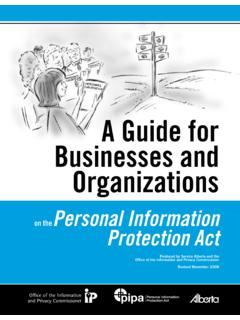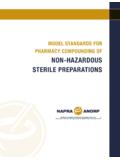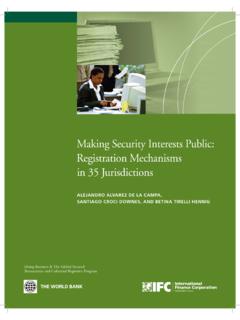Transcription of EXAMINATION PREPARATION GUIDE - NIDMAR
1 EXAMINATION PREPARATION GUIDE 2004 return to work coordinator EXAMINATION PREPARATION GUIDE Essential Skills and Competencies for the certified return to work coordinator (CRTWC) The certification process for the return to work coordinator involves the documentation of experience in the field, education and the successful completion of the certification EXAMINATION . This GUIDE reviews the background of the developmental process of this emerging field, the EXAMINATION and the content areas covered in the EXAMINATION . The EXAMINATION blueprint is provided to show the range of emphasis of the various occupational standards with the tool to GUIDE the study process.
2 Background Escalating disability costs for employers, workers and society in general, falling employment participation and hiring rates of persons with disabilities and increasing regulatory obligations for the reintegration of injured and disabled workers has led to a range of disability management and return to work initiatives. Best practice evidence and research has demonstrated that when properly developed, implemented and administered, consensus-based disability management / return to work programs can effectively reduce the socio-economic cost of disabilities for employers, workers and providers by a substantial margin while at the same time maintaining employability for workers with disabilities.
3 To ensure that these expectations are completely transferable, consistently achieved within a balanced framework across all operating environments, and meet the unique needs of all stakeholders, requires that a number of universally applicable principal requirements are met. This applies both to the design and implementation of policies and programs (Code of Practice) as well as the discrete set of characteristics in experience, skills and competencies (Occupational Standards) reflected by the individuals charged with disability management and return to work program development, implementation, maintenance and evaluation.
4 A labour market survey undertaken by NIDMAR in 2002, in collaboration with the University of Northern British Columbia, McMaster University, Ryerson University, Mohawk College and Human Resources Development Canada, surveyed more than 1,000 employers, unions, insurance and service providers across Canada and discovered the following: There is currently a shortage of qualified and competent practitioners and professionals in the field There is a growing need for competent professionals and practitioners due to an aging workforce, increasing disability costs and return to work obligations There is a demand for professionally trained individuals to carry out the tasks 2004 Page 2 Development of Occupational Standards A defined occupational standards development process, as set out by Human Resources Development Canada, was conducted with the support of governments.
5 Major employers, workers compensation boards and unions from across Canada. The process also benefited from the invaluable experience and knowledgeable contribution of professionals, practitioners and academics from a broad cross-section of stakeholder representatives from across Canada as well as from Australia, Europe, New Zealand and the The process culminated with the publication of the document, Occupational Standards in Disability Management ( NIDMAR , 1999), which has been endorsed for adoption by a cross-section of Canada s largest employers, unions and workers compensation boards.
6 Development of the Certification The process of creating psychometrically stable and defensible certification examinations based on the Occupational Standards was begun in 2001. Supported through government and a broad cross-section of leading Canadian employers, unions and workers compensation boards, unified in their quest for excellence and quality assurance in disability management and return to work , this highly technical task was performed by one of Canada s most reputable test development agencies, Assessment Strategies Inc., of Ottawa. Working with professionals and practitioners from all stakeholder groups and representing all regions of Canada and, following an internationally recognized test development protocol, this process culminated in the finalization of test examinations each comprising 300 multiple choice questions.
7 The EXAMINATION Committee s role was to review test materials, participate at critical points in the test development cycle such as competency and blueprint development, and approval of the EXAMINATION to ensure sufficient expertise is required to write the EXAMINATION . Firstly, the committee provided performance indicators for each of the core skills as outlined in the Occupational Standards. This information would be key for the item (question) writers in the development of the questions. Secondly, the committee participated in the development of a blueprint, shown below, which lists the competencies, how they are weighted in the EXAMINATION , the structure (number and kind of questions) and the content of the questions (legislation and benefit programs, disability case management, ethical and professional conduct, etc.)
8 This aspect of the blueprint is reproduced below. Each cell has a specified percentage range which represents the target number of questions to be on the EXAMINATION . There is also a set of contextual variables that sets the stage of the question. This includes consideration of a client s age, gender, culture, the organizational culture and the specific environmental setting. The blueprint will be revised over time as needed to reflect practice development. 2004 Page 3 Blueprint for Exam Structural Variables EXAMINATION Length and Format 300 objective multiple choice questions Question Presentation Independent questions Case-based questions 45 55% 45 55% Cognitive Domain Knowledge / Comprehension Application Critical Thinking 20 30% 45 55% 20 30% Competency Categories Disability Management Theory and Practice Legislation and Benefit Programs Labour / Management Relations Communication and Problem-Solving Skills Disability Case Management return to work Coordination Health.
9 Psychosocial, Prevention and Functional Aspects of Disability Program Management and Evaluation Ethical and Professional Conduct 5 15% 5 15% 5 15% 5 15% 10 20% 15 25% 5 15% 1 10% 5 15% Contextual Variables Client Age and Gender Client gender and age will only be specified where it is required for clarity or in order to provide guidance to the candidate Client Culture Questions are included that measure awareness, sensitivity and respect for different cultural values, beliefs, and practices, without introducing stereotypes Organizational Culture Questions are included that measure awareness, sensitivity and ability to work within a variety of organizational cultures Environment It is recognized that disability management is practiced in a wide range of settings and that for the purposes of the return to work coordinator Certification EXAMINATION , the environment is only specified where it is required for clarity or in order to provide guidance to the candidate 2004 Page 4 9 Domain Areas x 3 Levels of Reasoning (Knowledge.)
10 Application and Critical Thinking) Cognitive Domain Knowledge/ Comprehension Application Critical Thinking Disability Management Knowledge Theory and Practice Legislation and Benefit Programs Labour / Management Relations Communication and Problem-Solving Skills Disability Case Management return to work Coordination Health, Psychosocial, Prevention and Functional Aspects of Disability Program Management and Evaluation Ethical and Professional Conduct Core Competencies based on the Occupational Standards The Item Generation Committee, comprised of subject matter experts from across Canada representing all stakeholders, developed a bank of questions and case studies, which were reviewed and approved by the EXAMINATION Committee.






